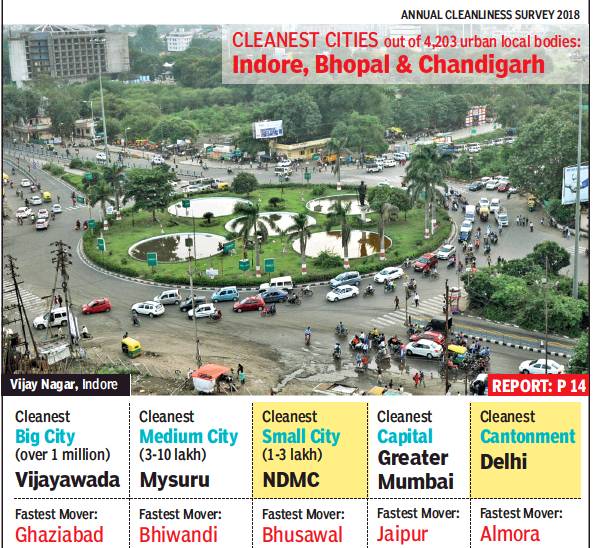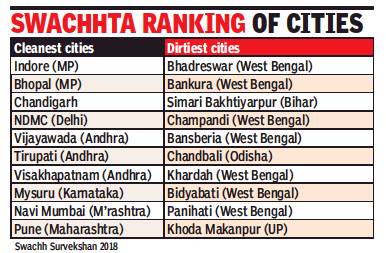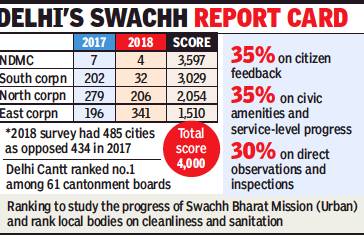Cleanliness ranks of Indian cities, districts: 2018
This is a collection of articles archived for the excellence of their content. |
Contents |
2018 ranks
Graphic: in a nutshell

From: May 17, 2018: The Times of India
See graphic:
The highlights of the annual cleanliness survey, 2018
The best and worst cities
Dipak Dash, ‘Bengal home to seven dirtiest municipal areas’, June 24, 2018: The Times of India

From: Dipak Dash, ‘Bengal home to seven dirtiest municipal areas’, June 24, 2018: The Times of India
Indore, Bhopal Retain Cleanest City Tag: Survey
West Bengal is home to seven of the ten dirtiest municipal areas in India while Uttar Pradesh has three dirtiest cities, including Khoda Makanpur in Ghaziabad district, according to the latest cleanliness ranking of municipalities by the Centre. Two municipal areas from Bihar and one from Odisha have also been ranked as the among the dirtiest.
Gonda in UP, which ranked 434 and was the dirtiest municipal area in 2017 survey, has climbed up to 228 among the 485 municipalities having more than one lakh population. West Bengal for the first time participated in the Swachh Survekshan this year, covering 4,203 municipal areas across the country. The report was released by PM Narendra Modi on Saturday.
Indore and Bhopal retain their earlier top two positions. While three cities — Chandigarh, Pune and Vijayawada — have made it to the list of best 10 urban areas. Surat, Tiruchirappalli and Vadodara have been pushed back. Chandigarh climbed to the third rank this year against its earlier rank of 11 while New Delhi Municipal Councilimproved its position to occupy the number 4 slot as compared with the seventh position in 2017. Tirupati has jumped to number six as compared to its ninth position last year while Navi Mumbai slipped by one rank to number nine. Mysuru’s has tumbled from number five to number eight in this year’s survey. The PM’s constituency of Varanasi has improved its position from 32 in 2017 to 29 this year.
The housing and urban affairs ministry said the an nual survey is aimed at bringing greater competition among urban local bodies to do more to make cities cleaner. The assessment of ‘swachhta’ involving citizens’ feedback in one year was termed as one of the biggest-ever surveys undertaken by any government across the globe.
Modi said the dream of a clean India is not far away. “During the past four years, we have built more than 8.3 crore toilets in rural and urban areas,” he said.
Individual regions
Bengaluru: Why it is not in the list
HIGHLIGHTS
Experts blame the assessment parameters of Swachh Survekshan for Bengaluru’s poor show
The survey focused more on surface cleanliness rather than ensuring sustainability
The list of cleanest cities in India has been made public by the Union ministry for housing and urban affairs, but Bengaluru has failed to feature among the top three despite being known as the most dynamic city. Why?
This has been the most discussed poser in civic corridors after the Swachh Survekshan 2018 results were declared two days ago. The survey covered 4,041 cities and urban local bodies and the parameters to adjudge cities included collection and transportation of waste, processing and disposal, sanitation, no open defecation and behavioural change brought about by information, education and communication.
Experts blame the assessment parameters for Bengaluru’s poor show, saying more weightage has been given to things like dustbins and hoardings instead of sustainability being achieved via long-term measures. Sandhya Narayan, member of the solid waste management round table, said though the blueprint of the micro plan remained largely on paper, there should have been a special mention of Bengaluru’s waste-processing capacity.
“I don’t think a good ranking could have been expected considering that a turnaround would have to be achieved in just a year. The assessment parameters of the survey are flawed to an extent: A lot of emphasis was given to dustbins in public areas but when waste is not collected and transported, the dustbins overflow and become black spots. The survey focused more on surface cleanliness rather than ensuring sustainability,” she said.
Adding that the feedback section of the survey is also questionable as citizens don’t know much about the ground reality, Narayan highlighted another problem — that of scale. “Cities with a population of 10 lakh can’t be compared to a city housing 100 lakh people. I’m not absolving BBMP of any responsibility, but problems in evaluation exist. We should have got a special mention for our comprehensive micro plan as well as our processing potential, which is presently at 2,300 tonnes,” she said.
The micro plan, launched by the health and solid waste management wing of BBMP’s health department last year, divided each ward into blocks of 750 households with designated facilities for each block.
Door-to-door collection
Swati Singh Sambyal, programme manager, waste management, Centre for Science and Environment, said cities should be evaluated on more than door-to-door collection systems. “In the 52 categories, a majority of the cities are only visibly clean with no appropriate systems for processing and disposal. They continue to indiscriminately dump waste in under-functional processing sites/landfills,” shesaid.
Delhi improves
Paras Singh, Capital climbs up on the Swachh ladder, June 24, 2018: The Times of India

From: Paras Singh, Capital climbs up on the Swachh ladder, June 24, 2018: The Times of India
But Poor Show By East Corpn As It Falls From 196 To 341
Barring the exception of East Delhi Municipal Corporation, all the urban local bodies in the capital have fared better in the Swacchh Survekshan, or the central survey of public cleanliness. New Delhi Municipal Council has provided the 43 sq km under its jurisdiction with such a high standard of cleanliness that it has been ranked 4th among 485 local bodies, while South Delhi Municipal Corporation displayed the biggest improvement, jumping from last year’s 202nd rank to 32nd this year.
In the separate category of rankings, the area under Delhi Cantonment Board has been adjudged the cleanest among the 61 cantonments in the country. While New Delhi was superseded only by Chandigarh at 3rd place among north Indian cities, SDMC received an overall 3,029 points and was placed below Jamshedpur and Warangal. The north corporation also improved its ranking from 279 last year to 206.
Among Delhi’s neighbouring cities, Gurgaon ranked 105th, up from 112 in 2017, behind Karnal at 41 and Rohtak at 89. Faridabad, however, lagged at the 217th spot.
Responding to its vastly improved show, SDMC commissioner Puneet Goel said it was due to the civic body’s focus on the modernisation of dhalaos and mechanisation of garbage collection. “Weekly review meetings, information and communication technology-based monitoring, and mechanisation of the collection and transportation of garbage helped us translated our swachhata initiatives into reality,” he said. “Our aim for the next survey will be too extend the waste-toenergy initiatives, create an engineered landfill and centralise processing of waste to ensure zero-waste localities.”
Now in their third year, the rankings study the progress of Swachh Bharat Mission and judge urban local bodies on cleanliness and sanitation. It offers a total of 4,000 points, of which 1,400 are for service delivery and civic amenities, 1,200 for direct observations and on-site inspections, and 1,400 for citizen feedback.
East Delhi, the most densely populated part of the city, slid from a good 196th rank last year to 341, just above Gondal in Gujarat. EDMC mayor Bipin Bihari Singh said that the dip was due to the fund crunch. “How can the ranking improve when there is no money even to pay the salaries of our workers? Delhi government has reduced our allocations and we don’t even have funds to run the necessary numbers of auto-tippers or to modernise our garbage collection mechanism,” said Singh, also pointing out that east Delhi was the most challenging region in the capital given the preponderance of unauthorised colonies and JJ clusters.
Reacting to the rankings, Swati Sambyal, an expert on waste management at the Centre for Science and Environment, observed that even though the overall ‘visible cleanliness’ had improved in the course of the year, the waste processing practices in the city were not sustainable because the focus continued to be on collecting and incinerating waste.
Sambyal said that the ranking methodology should go beyond judging cities based only on visible cleanliness. “We see Delhi’s agencies demanding more land for locating landfills and people protesting over dumps being proposed in their locality,” she said, also pointing out that while the south corporation had indeed focused on using waste compactors and mechanising garbage disposal, only 8% of its waste was “being segregated” as required by green practices.
Ghaziabad: fastest mover
Abhijay Jha, Ghaziabad ranks 36th, gets ‘fastest mover’ tag, June 24, 2018: The Times of India
Ghaziabad has been ranked at the 36th position with 2,992.68 points in the Swachh Survekshan 2018. In Uttar Pradesh, Ghaziabad is second only to Varanasi, which tops the ranking with 3,052.03 points. Varanasi’s All-India rank is 29.
Ghaziabad, to its credit, has also been adjudged as the country’s ‘fastest mover’ city in 2018, moving 315 places up to secure the 36th rank.
Ghaziabad mayor, Asha Sharma, and GMC commissioner, CP Singh, were felicitated by PM Narendra Modi in Indore on Saturday for achieving the ‘fastest mover’ tag. Municipal commissioner CP Singh said that it was a “rare achievement, which would not have been possible without the support of Ghaziabad residents.”
In 2017, Ghaziabad was ranked 351. Its turnaround this year could be attributed to a coordinated effort by several government agencies, spearheaded by the Ghaziabad Municipal Corporation.
Jharkhand tops among states
Dipak Dash, June 24, 2018: The Times of India
Jharkhand has been ranked as the best performing state on swachhta parameters, followed by Maharashtra, Chhattisgarh and Madhya Pradesh. West Bengal, Delhi, Bihar and Odisha are the worst performers. The national capital ranked at 25 out of 30 states and UTs, according to the latest swachhta survey. However, Delhi scored better over most of the states and UTs in solid waste management. According to the Swacch Survekshan report, Jharkhand had the maximum score based on four parameters. These are service level progress, direct observation by the assessors, citizens feedback and solid waste management.
The best…=
Cities
Ministry of Housing and Urban Affairs
RANK
CITY NAME
SCORE
- 1
3707.01
- 2
3688.94
- 3
3649.38
- 4
3597.19
- 5
3580.24
- 6
3575.8
- 7
3546.5
- 8
3539.58
- 9
3536.23
- 10
3471.34
- 11
3459.1
- 12
3372.91
- 13
3351.69
- 14
3318.43
- 15
3297.37
- 16
3291.94
- 17
3197.89
- 18
3174.59
- 19
3172.62
- 20
3161.68
See also
Cleanliness ranks of Indian cities, districts: 2014-15
Cleanliness ranks of Indian cities, districts: 2016
Cleanliness ranks of Indian cities, districts: 2017
Cleanliness ranks of Indian cities, districts: 2018